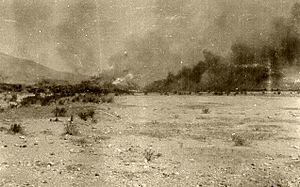Operations against the Mahsuds (1917) facts for kids
Quick facts for kids Operations against the Mahsuds |
|||||||
|---|---|---|---|---|---|---|---|
| Part of World War I | |||||||
 A Mahsud village burning during the 1917 operations. From 15–19 June, British forces burnt and looted several abandoned Mahsud villages in their vicinity without opposition. |
|||||||
|
|||||||
| Belligerents | |||||||
| Mahsud tribesmen | |||||||
| Commanders and leaders | |||||||
| Major-General William Benyon | Mahsud leader | ||||||
| Units involved | |||||||
|
Mahsud tribesmen | ||||||
In 1917, the British Empire carried out military actions against the Mahsud people. This was a successful operation to stop raids and bring peace to the North-West Frontier Province in what is now Pakistan.
Contents
Why the Conflict Started
After a previous military action in 1900-1902, the Mahsud people had signed a peace agreement with the British. This agreement brought a temporary end to fighting.
However, in November 1913, the Mahsud leader, Mulla Powinda, passed away. His son, Fazl-Din, did not follow the peace agreement. He started new raids. People in the Afghan government who supported Turkey and disliked the British encouraged these attacks.
Raids and Growing Tensions
The fighting between the British and the Mahsud began in April 1914. This event was called the "Tank outrage." During this incident, Mahsud fighters killed Major Dodd, a British official, along with two other officers and three soldiers.
From April 1914 to March 1915, the Mahsuds carried out 81 serious raids. These did not include smaller crimes like stealing cattle or cutting communication wires.
By 1916, the British leader in India, Viceroy Frederic Thesiger, was told that "no village is safe." The Mahsuds were raiding far from their homes, harming and kidnapping people. It was a very difficult situation for the local people.
In March 1917, the Mahsuds began raiding into areas controlled by the British. Their attacks on British outposts, soldiers, and supply convoys led the British to launch a major military operation in June. The British wanted to show their strength and stop the attacks after suffering many losses.
The Conflict Itself
British forces, led by Major-General Benyon, moved into Mahsud territory on June 6. They fought the Mahsud people on several days in June: the 7th, 12th, 19th, 20th, 21st, 23rd, and 24th.
On June 25, the fighting stopped. The Mahsuds began asking for peace. One of the conditions for peace was that the Mahsuds had to return any rifles they had stolen. Some of these stolen weapons were given back to the British soldiers while they were still in the area.
British troops started leaving the area on July 12. The final peace agreement was reached on August 10, 1917. This agreement was made with a Mahsud jirga, which is a traditional council of elders.
What Happened Next
The news of the peace agreement was a great relief to the British government department responsible for India. They were happy that the North-West Frontier of India was finally free of trouble.
With the Mahsuds defeated, India's military resources could be used elsewhere. In mid-July, two battalions (groups of soldiers) were sent to help the Allied war effort in East Africa.
See also
- Mohmand blockade
- Operations against the Mohmands, Bunerwals and Swatis in 1915

